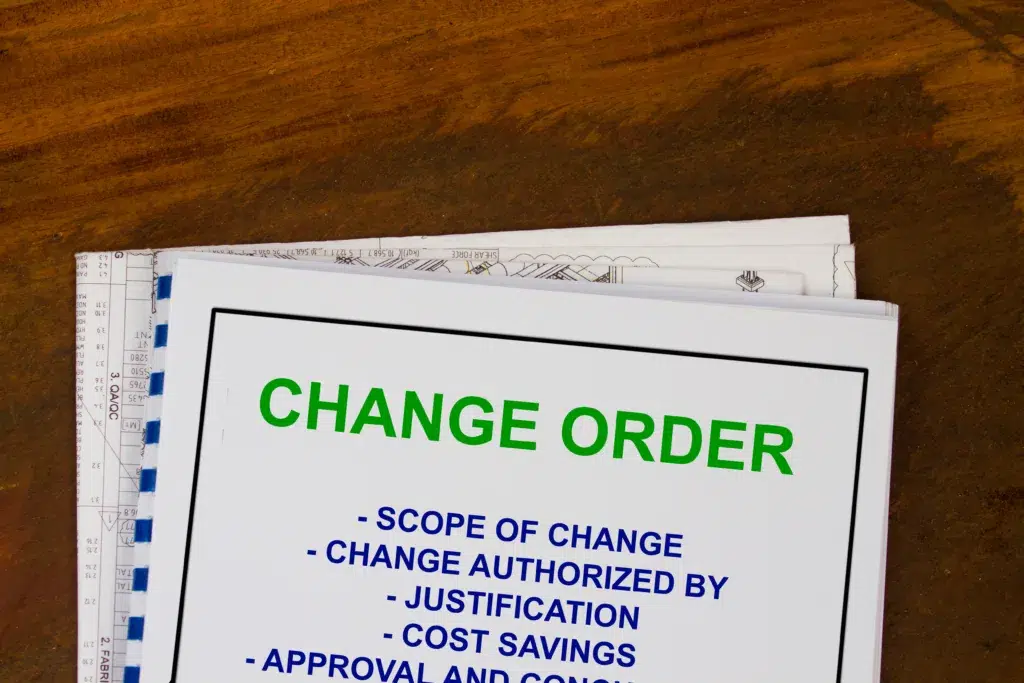Table of Contents
A construction change order is a document used to record an amendment to the original construction contract. It details changes in scope, price, time, or other terms agreed upon by the parties involved. Writing a clear and comprehensive change order is crucial to ensure the contractor and the client understand and agree to the changes. Here’s a step-by-step guide on how to write a construction change order:
1. Start with Basic Information
Every construction change order begins with the foundational step of documenting basic yet crucial information. This initial section sets the stage for the entire document, ensuring that anyone reviewing the change order can immediately understand its context and relevance. Here’s what to include:
Project Name/Number
The project name and number are essential for identifying the specific project to which the change order applies. To avoid confusion, this information should match the documentation used in the original contract and any previous communications.
Change Order Number
Assign a unique number to each change order. This practice helps in tracking and referencing change orders throughout the project. It’s common to start with “Change Order No. 1” and sequentially number subsequent orders.
Date
The date when the change order is issued is critical. It records when the agreement to make changes was formalized, which can be important for project timelines and legal records.
Contractor and Client Information
Include the contractors’ and clients’ full names, addresses, and contact information. This ensures the document is directed correctly and can be referenced in communications. Clear identification helps maintain the link between the change order and the parties involved.
This basic information, though straightforward, is the bedrock of an effective change order. It ensures clarity from the outset, providing a precise reference point for all subsequent details and discussions. By documenting this information, you lay a solid foundation for the transparent and efficient handling of changes, keeping the project on track and maintaining strong contractor-client relations.
2. Reference the Original Contract
After establishing the basic information, the next crucial step in writing a construction change order is firmly anchoring it to the original contract. This connection ensures that both parties understand the context and baseline from which changes are made. Here’s how to effectively reference the original contract in a change order:
Original Contract Date and Number
Begin by citing the original contract’s date and number. This reference directly links to the foundational agreement between the contractor and client. Providing these details makes retrieving and reviewing the original terms easier and facilitates a clearer understanding of the proposed changes.
Description of Original Scope
Provide a brief overview of the project’s original scope as the contract outlines. This doesn’t need to be exhaustive but should highlight the key deliverables and objectives that the project was set to achieve. This summary helps frame the nature of the change order concerning the project’s intended outcome.
Importance of Accurate Referencing
Accurate referencing to the original contract is not just a matter of administrative diligence. It serves several critical functions:
- Clarity: It clarifies the baseline from which changes are being proposed, helping to mitigate misunderstandings about the project’s scope and terms.
- Legality: In the event of disputes, clear references to the original contract within change orders can be vital in resolving legal matters, as they demonstrate how and why the project has evolved over time.
- Financial Implications: Changes often have financial implications. Referencing the original contract helps assess these implications accurately, especially when additional costs or savings arise from the proposed changes.
Consistency and Confirmation
Ensure that the information provided matches the details in the original contract exactly. Any discrepancies in dates, numbers, or descriptions could lead to confusion or disputes down the line. It’s also wise to confirm that both parties have the same understanding of the original contract terms before finalizing the change order.
Referencing the original contract effectively sets the stage for understanding and agreeing to the following changes. It underscores the importance of the change order in adapting the project’s path while respecting the original agreement’s boundaries. You lay the groundwork for a transparent and mutually agreed-upon course of action by linking the change order to the original contract.
3. Describe the Change
The core of a construction change order lies in its detailed description of the change itself. This section outlines the specifics of the project adjustment, including what is being changed, why the change is necessary, and how it will be implemented. Here’s how to effectively articulate these details:
Detailed Description of the Change
Start with a clear and comprehensive description of the change. This should include:
- What is Changing: Specify the nature of the modification, addition, or removal in the project scope. The description must be precise, whether it’s a change in materials, design specifications, site conditions, or construction methods.
- How the Change Will Be Implemented: Outline the steps or methods that will be used to incorporate the change into the project. This might involve technical descriptions, workforce allocation adjustments, or project timeline modifications.
Justification for the Change
Explain why the change is necessary. The justification should be compelling and backed by solid reasoning, such as:
- Unforeseen Conditions: Issues not apparent at the project’s outset, such as unexpected site conditions or material shortages.
- Client Request: Changes requested by the client for reasons such as preference, functionality, or satisfaction.
- Regulatory Requirements: Modifications required to comply with new or previously unaddressed legal or safety regulations.
- Cost Efficiency: Changes that, while altering the original plan, provide long-term savings or efficiency gains.
Impact Analysis
Discuss the anticipated impact of the change. This includes:
- Scope Impact: How the change affects the project’s overall scope, potentially altering deliverables or outcomes.
- Technical Impact: Considerations on how the change might affect the technical execution of the project, including challenges or benefits to the construction process.
Visuals and Supporting Documentation
Whenever possible, include drawings, plans, or other visual aids that support the detailed description and justification of the change. This can help clarify complex changes and ensure all parties understand the proposed modifications.
The “Describe the Change” section is pivotal in ensuring that all parties involved thoroughly understand the modifications to the project. It serves to document the change and provide a rationale that supports the decision-making process, fostering transparency and mutual agreement by detailing what is changing, why, and how you lay the groundwork for a smooth transition and implementation of the change, minimizing disruptions and maintaining project integrity.
4. Detail the Impact of the Change
After describing the change, the next crucial step is to comprehensively analyze and document its impact on the project. This analysis is essential for understanding the full implications of the change, including how it affects the project’s scope, budget, and timeline. Here’s how to thoroughly detail the impact of the change:
Scope Impact
- Adjustments in Project Deliverables: Explain how the change affects the project’s deliverables or outcomes. Does it expand or reduce the scope of work? How does it alter the end product expected by the client?
- Quality Considerations: Assess if the change will affect the quality of the finished project, either by enhancing it with better materials or methods or by necessitating compromises.
Cost Impact
- Detailed Cost Breakdown: Provide a detailed breakdown of the costs associated with the change. This should include direct costs like materials and labor and indirect costs such as additional project management or administrative fees.
- Comparison to Original Budget: Highlight how these costs impact the original budget. Specify whether the change will lead to an increase in the overall project cost and by how much.
- Justification for Cost Changes: Explain why the cost changes are necessary, offering a clear rationale supporting additional expenses or savings.
Time Impact
- Adjustment to Project Timeline: Detail how the change will affect the project’s timeline. Will it lead to delays, or could it possibly expedite the completion date?
- Specific Timeframe Changes: Offer specific details on the expected adjustments to the project schedule, including any new milestones or deadlines that must be met.
- Rationale for Timeline Adjustments: Provide justification for any changes to the timeline, whether they are due to the complexity of the changes, availability of materials, or other factors.
Approval and Documentation
- Necessity for Formal Approval: Emphasize the importance of obtaining formal approval from all relevant parties on the impacts detailed in this section. This step ensures everyone knows and agrees to the scope, cost, and time adjustments.
- Documenting Agreement: Stress the need to confirm this approval in writing as part of the change order to avoid any misunderstandings or disputes in the future.
Detailing the impact of the change is essential for maintaining transparency, managing expectations, and ensuring project success. This section informs all stakeholders of the adjustments and provides a basis for informed decision-making. By clearly articulating the effects on scope, cost, and time and securing formal approval, you pave the way for a smooth implementation of the change, keeping the project on track toward its revised objectives.
5. Approval Signatures
The culmination of the change order process is the acquisition of approval signatures from all key stakeholders. This step is critical as it symbolizes mutual agreement and formal acceptance of the change, including its impacts on the project’s scope, cost, and timeline. Here’s how to effectively manage this phase:
Collecting Signatures
- Identify Required Signatories: Determine who needs to sign the change order. This typically includes representatives from both the contracting party and the client but may also involve architects, engineers, or other stakeholders depending on the project’s complexity and the nature of the change.
- Signature Authority: Ensure that individuals signing the change order have the authority to approve changes on behalf of their respective organizations. This is crucial for the change order to be legally binding.
Documenting Agreement
- Clear Acknowledgement: The change order should include a section clearly stating that the signatories agree to the changes described, including any adjustments to the project scope, budget, and timeline.
- Date of Signatures: Record the date each party signs the change order. This helps track the approval process and can be important for project scheduling and legal purposes.
Importance of Approval Signatures
- Legal Binding: Signatures transform the document from a proposal into a legally binding agreement that modifies the original contract. This is essential for enforcing the terms of the change order.
- Confirmation of Agreement: The signing indicates that all parties have reviewed, understood, and agreed to the changes and their implications. This mutual agreement is critical for maintaining positive relationships and minimizing disputes.
Handling Disagreements
- Negotiation Process: If disagreements arise during the change order review, engage in a negotiation process to address concerns. This may involve revising the change order to accommodate reasonable requests or clarifying misunderstandings.
- Documentation of Revisions: Any changes made to the change order during negotiations should be documented and approved by all parties, ensuring that the final document reflects a consensus.
Final Steps
- Distribution of Finalized Document: Once signed, distribute copies of the change order to all relevant parties. This ensures everyone has the latest information and documentation related to the project changes.
- Record Keeping: In the project files, maintain a record of the signed change order. This documentation will be crucial for reference throughout the remainder of the project and for any future needs.
The “Approval Signatures” section is a vital component of the change order process, serving as the definitive agreement that allows the project to move forward under the new terms. By securing these signatures, the project team ensures that the change is officially recognized, agreed upon, and enforceable, paving the way for successful implementation and completion of the project adjustments.
6. Attachments and Documentation
The final step in preparing a comprehensive construction change order involves the inclusion of relevant attachments and documentation. These supplementary materials are crucial in providing clarity, supporting the rationale for changes, and ensuring a seamless implementation process. Here’s how to effectively manage this aspect:
Types of Attachments
- Detailed Drawings and Specifications: Include any architectural or engineering drawings that have been updated to reflect the change. These can help visualize the alterations and ensure all parties understand the new requirements.
- Revised Schedules: If the change impacts the project timeline, include a revised schedule highlighting milestone adjustments and completion dates.
- Cost Estimates: Attach detailed cost breakdowns or estimates supporting the change order’s figures. This could include subcontractor quotes, price lists for materials, or any other relevant financial documentation.
- Regulatory Approvals: If the change requires new permits or approvals from regulatory bodies, include documentation that these have been obtained or are in the process of being secured.
Importance of Comprehensive Documentation
- Clarity and Transparency: Providing thorough documentation helps prevent misunderstandings by ensuring all parties have access to the same detailed information.
- Facilitates Approval: Comprehensive attachments can aid in the approval process by offering concrete evidence supporting the necessity and feasibility of the changes.
- Legal and Financial Record: In the event of disputes or audits, these documents serve as a vital record, demonstrating due diligence and compliance with agreed-upon changes.
Managing Documentation
- Organize for Easy Reference: Ensure that all attachments are clearly labeled and organized in a manner that makes them easy to reference in relation to the change order.
- Digital Copies: Where possible, provide digital copies of all documentation to facilitate easy sharing and storage. This also helps in maintaining a backup of critical project documents.
- Confidentiality Considerations: Be mindful of the sensitivity of the information being shared. Securely handle documents that contain proprietary or confidential information, sharing them only with parties who require access.
Finalizing the Documentation
- Review for Completeness: Before finalizing the change order, review all attachments and documentation to ensure they are complete and accurately reflect the agreed-upon changes.
- Acknowledgment of Receipt: It’s advisable to obtain an acknowledgment from the receiving party that they have received and reviewed all attached documentation, further solidifying the mutual understanding and agreement.
Including attachments and documentation with a construction change order reinforces the details and justifications for the changes and provides a robust foundation for implementing the changes effectively. By diligently managing this aspect, project teams can ensure that changes are executed smoothly, with a clear record of the rationale, approvals, and expectations outlined in the comprehensive documentation.
Streamline your change orders with Bauwise change order management software
Bauwise offers user-friendly change order software that simplifies collecting, tracking, processing, and approving change orders. With its intuitive interface, you can easily create, modify, and manage change orders, ensuring that all modifications are accurately documented and efficiently processed. The software provides real-time updates and alerts, keeping all stakeholders informed and aligned when it is time to review and approve change orders. Try Bauwise for free today!
Written by

Taavi Kaiv
Taavi Kaiv is a construction specialist with over ten years of experience in the construction industry. Taavi is an accomplished construction project manager with many successful projects that have been completed under his guidance. Taavi holds a master’s degree in construction management from the Tallinn University of Technology. View profile
Related posts
Read our articles where you can find useful and relevant information about construction change orders:





